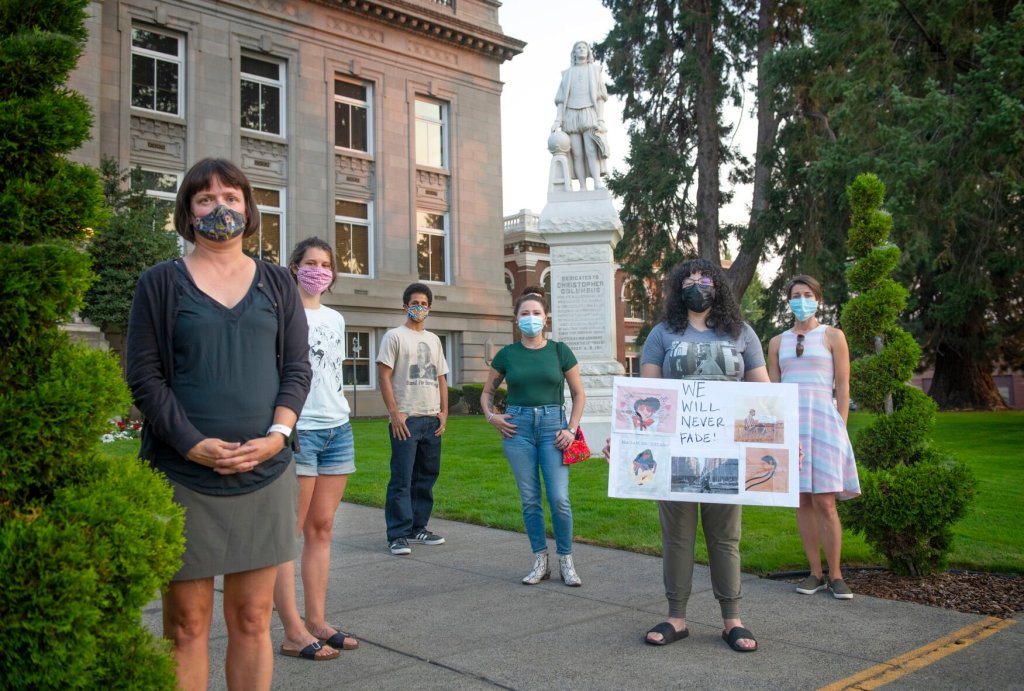Walla Walla debates future of Whitman statue
Published 11:00 am Monday, January 24, 2022

- Emily Tillotson, left, Hannah Bartman, Marc Adams, Cia Cortinas, Briana Spencer and Victoria Lidzbarski stand Aug. 19, 2021, near the statue of Christopher Columbus on the Walla Walla County Courthouse lawn. {div id=”highlighter--hover-tools” style=”display: none;”} {/div}
WALLA WALLA — More than a dozen members of the Walla Walla community and others spoke in support or in opposition to the removal of a statue of pioneer Marcus Whitman during a recent meeting of the city arts commission.
The statue of Whitman, the physician and missionary who established a mission nearly 200 years ago just west of what is now the city of Walla Walla, stands on the campus of Whitman College, which bears the figure’s name.
Whitman has come under renewed scrutiny in recent years for his role in the colonization of the region, helping to establish the Oregon Trail and the introduction of a measles outbreak that killed Native peoples. In 2019, a vandal defaced the statue with spray paint, misspelling the word “genocide” on its base.
Still, other members of the community oppose removing the statue, arguing doing so erases the legacy of a founding father of the region who sought to heal the sick.
The arts commission meeting Wednesday, Jan. 19, came in response to a request to remove the statue of Whitman that was started by Emily Tillotson, a professor at Walla Walla University.
That process, which allows a city resident to request reconsideration of any piece of public art the city owns, was created specifically in response to complaints about the statue of Whitman, Deputy City Manager Elizabeth Chamberlain previously told the Walla Walla Union-Bulletin.
In 2020, a local team of art researchers proposed removing the statue of Whitman and relocating it to Fort Walla Walla Museum.
“The statue tells us a lot, and it has a rich and fascinating history, but again, that history is not the history of Marcus Whitman, it is not the history of the Walla Walla Valley, and it’s not the history of Whitman College,” Libby Miller, director of Whitman College’s Maxey Museum and art history professor, said during a September 2020 Walla Walla Arts Commission meeting.
The statue, Miller and her team argued, does not represent the historical figure, a medical missionary from the 1800s. While Miller noted in an interview that she has since learned Whitman did on at least one occasion wear buckskins, it was not his typical style of dress, but appeared to be chosen by the artist to honor a symbolic representation of “frontier mythology.”
Arguments against the statue
During the arts commission meeting, Whitman College professor Stan Thayne, speaking on his own behalf, compared this depiction to the fictional monument of Jebediah Springfield on The Simpsons.
“My point here is that the coonskin cap frontiersman is a generic form of monumental-ization of every-town America,” Thayne said. “Every town has their coonskin cap frontiersman, violent killer who went and did the dirty work of the town to kind of clear the way so that white settlers could come settle there.”
Tillotson, speaking also on her own behalf Jan. 19, spoke in favor of removing the statue and potentially placing it in a museum. She argued against conceptions that monuments are meant to be permanent, stating the first monument to be remove in the United States was a statue of King George III in 1776.
“Folks are still digging up pieces of King George in their gardens in lower Manhattan,” Tillotson said. “Monuments are symbols of what we value as a community, and they should change and grow with us.”
Joy Garcia, a licensed clinical social worker serving as a therapist at Yellowhawk Tribal Center for the Confederated Tribes of the Umatilla Indian Reservation, argued the statue’s continued presence prolongs historic trauma against the region’s Indigenous peoples.
The CTUIR’s website states Whitman was killed in 1847 by a band of Cayuse, along with some of their Umatilla and Nez Perce allies, for a number of reasons, including for the stealing of Native property, encouraging the increase of immigration and the belief that Whitman, a doctor, had poisoned Native peoples.
The arts commission will meet again in March to consider its recommendationto the city council, though the exact time and date will likely not be set until the commission meets again Feb. 2. The Walla Walla City Council has the final say over the fate of the statue.





